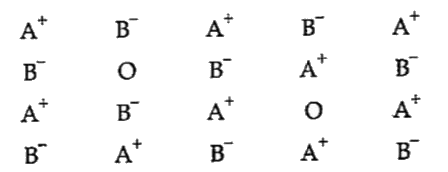What are the types of lattice imperfection found in crystals?
To answer the question about the types of lattice imperfections found in crystals, we can categorize them into two main types: point defects in stoichiometric crystals and point defects in non-stoichiometric crystals. Let's break this down step by step.
Step 1: Understand Point Defects in Stoichiometric Crystals
In stoichiometric crystals, the composition of the crystal is such that the ratio of the different types of ions is fixed and corresponds to the empirical formula. The two main types of point defects in these crystals are:
1. Schottky Defect: This defect occurs when there are vacancies created by the absence of ions from their lattice sites. Essentially, some cations and anions are missing, which maintains the overall charge neutrality of the crystal.
2. Frenkel Defect: This defect occurs when an ion (usually a cation) is displaced from its normal lattice position to an interstitial site (a space between the lattice points). This results in a vacancy at the original site and an additional ion at the interstitial site.
Step 2: Understand Point Defects in Non-Stoichiometric Crystals
In non-stoichiometric crystals, the ratio of ions is not fixed and can vary. There are three main types of point defects in these crystals:
1. Metal Excess Defect: This defect arises when there is an excess of positive ions (cations) in the crystal. This can occur due to the presence of anionic vacancies or the incorporation of extra cations into interstitial sites.
2. Metal Deficient Defect: This defect occurs when there are fewer positive ions than negative ions in the crystal. This can happen due to the presence of cation vacancies or when anions occupy interstitial sites.
3. Impurity Defect: This type of defect arises when impurity ions are present in the crystal lattice. These impurities can occupy lattice sites or interstitial sites, disrupting the regular arrangement of the crystal.
Summary of Lattice Imperfections
- Point Defects in Stoichiometric Crystals:
- Schottky Defect
- Frenkel Defect
- Point Defects in Non-Stoichiometric Crystals:
- Metal Excess Defect
- Metal Deficient Defect
- Impurity Defect
In stoichiometric crystals, the composition of the crystal is such that the ratio of the different types of ions is fixed and corresponds to the empirical formula. The two main types of point defects in these crystals are:
In non-stoichiometric crystals, the ratio of ions is not fixed and can vary. There are three main types of point defects in these crystals:
- Point Defects in Stoichiometric Crystals:
- Schottky Defect
- Frenkel Defect
- Metal Excess Defect
- Metal Deficient Defect
- Impurity Defect
Topper's Solved these Questions
- SOLID STATEBook:ICSEChapter:SOLID STATEExercise:EXERCISE (PART-II DESCRIPTIVE QUESTIONS) (LONG ANSWER QUESTIONS)
Explore 38 Videos
- SOLID STATEBook:ICSEChapter:SOLID STATEExercise:ISC EXAMINATION QUESTIONS PART-I (Objective Question)
Explore 5 Videos
- SOLID STATEBook:ICSEChapter:SOLID STATEExercise:EXERCISE(PART-II DESCRIPTIVE QUESTIONS) (VERY SHORT ANSWER QUESTIONS)
Explore 13 Videos
- SELF ASSESSMENT PAPER-8Book:ICSEChapter:SELF ASSESSMENT PAPER-8Exercise:QUESTIONS
Explore 11 Videos
- SOLUTIONSBook:ICSEChapter:SOLUTIONSExercise:MULTIPLE CHOICE QUESTIONS (Assertion and Reason based questions)
Explore 10 Videos
Similar Questions
Knowledge Check
Examine the given defected crystal

Answer the following questions:
What type of stoichiometric defect is shown in the crystal ?ASchottky defect, decreases, NaCl and KCl etcBFrenkel defect, increases, As and Si etcCSchottky defect, increases, As and Bi etcDFrenkel defect, decreases, NaCl, KCl etc
What type of stoichiometric defects are noticed in crystals?
View SolutionWhat are the two types of proteins found in a plasma membrane?
View SolutionWhat is an ideal crystal ? Name the types of the defects which arise in a crystal.
View SolutionWhat do you understand by imperfections in ionic crystals? Name the types of imperfections which generally occur in ionic crystals.
View SolutionWhich types of Bravais lattice is not present in cubic crystal system ?
View SolutionFor crystal sodium chloride, state
(i) the type of lattice in which it crystallises.
(ii) co-ordination number of each sodium ion and chloride ion in the crystal lattice.
(iii) number of sodium and chloride ions present in a unit cell of sodium chloride.
(iv) the structural arrangement of sodium chloride crystals.
View SolutionDetermine the type of cubic lattice to which the iron crystal belongs if its unit cell has an edge length of 286 pm and the density of iron crystals is 7.86g cm−3.
View Solution